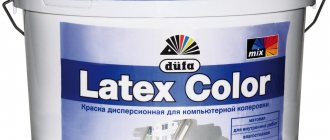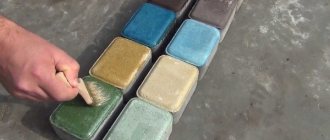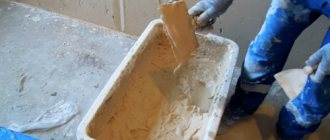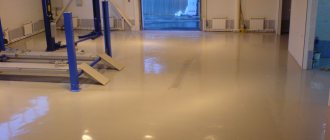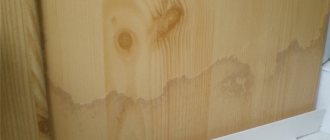The question of how to paint paving slabs arises quite often. This is due to the wide variety of materials of the final products from which they are made. The degree and possibilities of coloring are largely influenced not only by the internal composition itself, but also by the method of their manufacture.
Moreover, some do not require painting at all, but are already completely finished products.
If, however, there is a need to play with colors and organize an original landscape design on the site of a country house, we will tell you all the subtleties of the process and the choice of materials suitable for this purpose.
Pros and cons of the approach
As a rule, this situation arises when producing paving slabs and their curbs independently. Often, to give the required color, coloring pigments are added inside the cement mixture, which correspond to the appropriate color shade.
In such cases, in order to find out exactly how to properly paint paving slabs with your own hands, you will have to perform several tests with mixing and application.
Moreover, it is very important to remember or better even write down the obtained proportions. As soon as you get the right color, you can use the identified formula and begin painting all the products for the garden path.
There are also situations in which the entire path has long been laid out, but its dull and dull color does not please the owners, and there is clearly a need to make changes. There are a lot of nuances in preparing the right mixture.
It is also important to consider all the pros and cons of coloring. Let's start with the first ones:
- the appearance of the paving slabs will be significantly transformed and will be more compatible with the objects already selected for the suburban area and placed on it in terms of landscape design;
- an additional external coating will add durability to the base material, due to which the entire structure will have improved wear resistance characteristics in relation to mechanical stress, as well as moisture;
- there will clearly be a significant reduction in the sliding effect in unpleasant weather;
- The service life of the tile will be increased due to the correctly selected coloring composition.
But there are a number of disadvantages to consider, as well as potential problems that may arise:
- the painting procedure (as far as everyone knows) requires regular repetition and updating; in the best situations, the next application will need to be done after 8-12 years;
- the process is sometimes considered even more labor-intensive than laying the tiles itself, often takes up to several days and often involves applying coloring pigments in several layers, that is, several times over all surfaces of the products;
- Some of the dyes may have toxic emissions or fumes, so this should also be taken into account in advance.
Read also: What is tumbled stone?
Advantages and disadvantages of coloring
Before purchasing the necessary materials and starting work, it is advisable to understand the advantages and disadvantages of this method of updating paths. This, at first glance, simple technology requires the utmost attention from the performer when performing it, because any deviation can lead to the fact that after 2-3 years the paint coating can come off and it will be much more difficult to correct the situation.
The positive qualities of surface paint applied to paving stones are:
- the appearance of the sidewalk or paved area is radically transformed, changing the entire landscape design for the better;
- the layer not only gives the surface a beautiful appearance, but also provides good protection from harmful atmospheric and mechanical influences;
- slipping is reduced in the cold season and after rain in summer;
- special paints, together with pre-treatment, increase the service life of the tile itself.
In addition to its positive qualities, this method also has serious disadvantages:
- the need for periodic repainting of the surface, which can be repeated every 8-12 years;
- the complexity of carrying out work that will take at least several days;
- danger of poisoning from toxic fumes during work.
To avoid poisoning, painting paving slabs is carried out wearing a respiratory mask, periodically taking a break for an hour and a half.
Types of paints
Next we will talk about what paint to paint paving slabs, and which one is most suitable in different cases. Today, paints from:
- rubber;
- alkyd;
- polyurethane.
All of the options listed above have increased wear resistance and are almost not subject to environmental influences. Sometimes in these cases it is not possible to select the desired shade, then there is the possibility of variation by adding a lighter coloring pigment. This will help transform the resulting color into a more suitable one.
Often, special acid-based mordants are used to improve the quality characteristics of concrete. They are applied to the surface and play an important protective role as a basis for the subsequent painting procedure.
To understand the best way to paint paving slabs, let’s take a closer look at the subtypes of paints:
- Rubber paints are water-based and therefore rely on the use of additional color pigments. They have good elasticity, are waterproof, subsequently cracks do not form on them and they well prevent the effect of sliding on the surface of the tile. At the same time, they are not susceptible to exposure to ultraviolet rays and changes due to temperature changes. An additional advantage will be the absence of odor and toxic inclusions. Environmentally safe for humans and animals, as well as the environment.
- Alkyd ways to provide enhanced protection for paving slabs. They have increased resistance to high loads and are moisture resistant. After drying, they are not affected by chemicals. But in this case there is a rather sharp and unpleasant odor during application. However, it can persist for a long time, which is also a disadvantage.
- The polyurethane version has high impact strength. At the same time, they have high chemical and mechanical wear resistance. Of all the possible options, only this paint can be applied even at sub-zero temperatures outside. It does not have an unpleasant pungent odor. In addition, it dries quickly. But over time, it tends to fade the original shade, so repeating the dyeing procedure will be more frequent.
Read also: How to fill the seams of paving stones?
Coloring in the mass during production
Not every color on the counter of a hardware store can be added to concrete. You can find out whether it is possible to use pigment when mixing structural material for paving slabs, taking into account the following nuances:
- It is prohibited to contain zinc, lead, other heavy metals and their salts in the color, as they sharply reduce the adhesion of cement stone;
- Only UV-resistant and alkali-inert dyes should be used;
- pigments can absorb up to ¼ of the volume of liquid from concrete, disrupting the hydration process;
- The covering power of the pigment increases as its fineness decreases.
Important! Without reducing the strength of concrete, the bright color of the tile is ensured by introducing no more than 5% of the mass of cement into its composition of pigment.
Organic-based pigments are not suitable for concrete; mineral dyes (metal oxides) are used. The most commonly used pigments are brown, yellow and reddish shades (iron oxide), less often white (titanium oxide), purple, blue, green and other dyes are rarely used and are more expensive.
Pigments for concrete based on metal oxides.
We wrote about how tiles are made at home here.
Double-layer FEM elements
The main problem in the manufacture of colored FEM elements is the sharp increase in cost when dyeing in bulk. Therefore, the technology of two-layer paving slabs is used:
- not all the concrete is mixed with the pigment, but 1/3 of the total volume of the batch;
- the form is filled one third with the color mixture, which is distributed inside it on a vibrating table for 20 seconds;
- then the form is filled to the top with ordinary gray concrete;
- after 40 seconds of vibration, the form is removed for drying or stripping.
Double-layer paving slabs.
Advice! Depending on what kind of concrete is used for paving stones, the product will be painted entirely or in spots, since the dye is not able to saturate the crushed stone. Therefore, for paving slabs, sand concrete without coarse aggregate or a CPS mixture in a proportion of 1/3 is more often used, respectively.
Basic recommendations
Next, to understand how to paint paving slabs with your own hands, you should take into account a number of recommendations from experts in the construction field.
Painting of paving slabs is most often carried out outdoors, that is, in the open air. For this reason, it is imperative to take weather conditions into account. That is, you will have to look at the weather reports for the next few days in advance.
Most types of dyes require dry and windless weather where temperatures will be above 10 degrees Celsius. Only polyurethane versions can be applied at low temperatures. But it is still recommended to use the instructions supplied with the paints before applying.
If the weather will be different in the coming days, but you still need to start coloring, then we recommend doing it in stages, skipping more days. The absence of wind is also an important condition.
For step-by-step painting, you can divide the path into sectors, each of which is then painted gradually on different suitable days. The process of achieving the final result, of course, can be seriously delayed.
Is it possible to paint paving slabs and with what?
There are a variety of outdoor tiles on sale; they differ in color and shape. Also, craftsmen sometimes resort to making concrete sidewalks themselves, then pigment is added to the composition to obtain the desired shade. Or it can be carried out after applying paint for street tiles.
You can do the same if the paths were made earlier and do not have a beautiful shade, it is only important to choose a reliable paint and varnish material.
There are a variety of outdoor tiles on sale; they differ in color and shape.
Painting stages
To paint paving slabs with your own hands, you will need to carefully prepare the surface of the products. First, it is necessary to remove debris and dirt particles. A vacuum cleaner with high power is good for this. It is also important to ensure that the tile surface is completely dry before painting.
Preparatory work
In addition, it is recommended to use acid pickling to improve the quality properties of products. It becomes not only a simple additional layer, but penetrates into the structure of the concrete, and at the same time subsequently helps to perform better coloring of the deep layers.
Coloring
Next, you need to decide how and with what to paint the paving slabs in the yard. To do this you will need a paint roller or a regular wide brush. Application is carried out in 2-3 layers sequentially and carefully. But this can only be done after following the rule of completely drying the previous layer.
If alkyd or rubber paint will be used to ensure deeper penetration, it is worth adding a little mineral turpentine at 20%. But the addition should be done only with the first layer, and not with the subsequent one.
View this post on Instagram
Publication from paving slabs (@trotuar_plitka_07) Aug 30, 2020 at 9:31 PDT
If it is necessary to paint a large area, then the solution must be constantly stirred to obtain uniform color. Never use a spray gun. Here you will need to press or rub the dye into the surface of the paving slabs.
Read also: What types of paving slabs are there?
Upon completion of work
Until the mixture has completely hardened, it should not be touched and certainly not walked on. It is worth understanding that the upper layers slow down the drying process of the lower layers. Therefore, this aspect can be taken into account in advance.
At the end of the work, it is worth saving at least one package or jar. After a few years, you will need to return to it to remember what type of dye was used previously. This way there will be no problems with selection in the future. Moreover, it is better to continue to use exactly the same paint that was used the first time.
From this we can conclude that there are no problems in learning how to paint paving slabs with your own hands. The process is a fairly easy and simple process with a minimum number of available tools.
After completion of work
Even after the paint surface becomes dry to the touch, you should not walk on it for several days. The fact is that only the top layer (for example, the third) has finally dried out. But it slows down the final drying of the lower layers. This point must be taken into account when planning work, so that it does not turn out that you cannot enter the house without damaging the fresh paint coating.
Be sure to save one empty paint can or its label. After 5-8 years you will have to tint the tiles, and you can easily choose a material to renew the surface. If you used pigment to change shades, then save information about it.
It is possible to achieve a high-quality and beautiful surface of paths and areas paved with paving slabs, regardless of its shape and past service life. As a result, you can update the overall landscape design of the site and provide good additional protection for the material.
Design
The pressing question of how to paint paving slabs on the street arises when you are not satisfied with the current coating of garden paths. Sometimes even at the stage before installation. It should be understood that the visual design of these elements makes them components of the overall decorative design of the entire site.
For this reason, you need to think through and select the colors that are most advantageous and visually consonant with other objects on the site. Sometimes paving slabs and curbs are painted in the same way as the base of a building or the façade of a well.
This ensures visual compatibility of elements and makes the landscape design attractive. Based on this, it will be easier to decide how to paint paving slabs.
Similar articles:
Benefits of coloring
Paint for paving slabs is often used to improve surface protection from harmful external factors. This method helps to give the material better decorative properties. Among the advantages are the following points:
- The durability of the material is extended;
- A layer of paint makes the base less slippery;
- The coating is wear-resistant;
- Availability of a large assortment of flowers to obtain a beautiful yard design.
Paint for paving slabs is often used to improve surface protection from harmful external factors.




